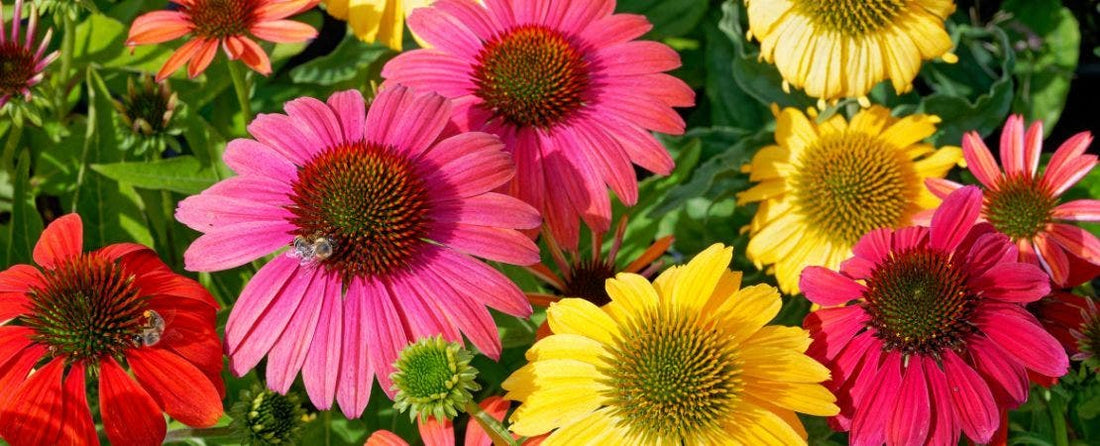Comprehensive Care Guide for Growing Echinacea

The Enchanting Native Coneflower Has Beauty and Benefits
Echinacea, commonly known as coneflower, is a native North American perennial that has captured the hearts of gardeners worldwide. Its vibrant flowers and ease of care make it a favorite in gardens and landscapes. Find essential tips and insights to help you successfully grow and enjoy echinacea in your garden.
Why Grow Coneflower?
Echinacea plants are visually striking with their bold blooms and sturdy stems, they're also renowned for attracting pollinators like bees and butterflies. Additionally, echinacea has been used in herbal medicine for centuries, touted for its immune-boosting properties. By incorporating these resilient plants into your garden, you'll enjoy a long blooming season and the lively activity of beneficial insects.
Choosing the Right Echinacea Variety
With the surge in plant breeding programs, echinacea now comes in a wide array of colors and forms, ranging from the traditional purple coneflowers to varieties in pink, red, yellow, and even green. When selecting echinacea for your garden, consider the plant's mature size, bloom color, and petal shape to create the desired look in your garden space.
Planting Echinacea for Success
Site Selection: Echinacea thrives in sunny to lightly shaded locations. Full sun encourages the most vigorous growth and abundant blooms, but these hardy plants can also perform well with a bit of afternoon shade, especially in hotter climates.
Spacing: Plant echinacea 18 to 24 inches apart to ensure adequate air circulation and room for growth. Proper spacing helps maintain plant health and allows each plant to develop a strong presence in your garden.
Soil Preparation: Before planting, prepare the soil by removing any weeds or debris. Loosen the soil and mix in organic matter to improve drainage and nutrient content. Coneflowers prefer rich, well-drained soil. If you're working with heavy clay or sandy soil, amend it with compost or organic matter to improve soil structure and fertility. This preparation will ensure that your echinaceas establish well and thrive.
Planting Depth: Dig a hole slightly larger than the size of the pot or root ball. Place the plant in the hole, making sure the crown sits level with the soil surface. Firmly press the soil around the roots and water in to eliminate air pockets.
Echinacea: Care and Maintenance Tips
To ensure your coneflower plants thrive and delight with their vibrant blooms, follow these easy care and maintenance steps:
- Mulching: Apply a layer of mulch around your plants to help conserve moisture, suppress weed growth, and regulate soil temperature. Use organic mulch such as wood chips or straw, and make sure to keep the mulch several inches away from the base of the plant to allow air circulation.
- Deadheading and Pruning: Extend the flowering season of your Coneflowers by regularly removing faded blooms through a process known as deadheading. This practice not only encourages the growth of new flowers but also prevents the plant from expending energy on producing seeds. Cut the stem just above a set of healthy leaves or a bud. In late winter or early spring, before new growth begins, you can also prune back the plants by about half to promote bushier growth.
- Watering: Water your newly planted echinacea thoroughly after planting. Keep the soil moist but not overly wet until the plants establish. Once established, Coneflowers are fairly drought-tolerant, needing watering only during dry periods. Avoid overwatering, as this can lead to root rot.
- Dividing Echinacea: Divide your established Echinacea plants every three years to maintain their vigor and promote healthy growth. Dividing Coneflowers rejuvenates them by reducing overcrowding, enhancing airflow, and preventing the spread of diseases. Spring or fall is the ideal time for dividing Coneflowers. Dig up the clump, carefully separate the individual crowns with roots, and replant them in the desired location. Use them to expand your garden or share with friends.
- Removing Chance Seedlings: Echinacea can self-seed in your garden, resulting in new plants popping up. However, these seedlings may not come true to color, and their presence can lead to overcrowding. As they appear, carefully remove any unwanted seedlings to maintain the desired aesthetic and ensure the health of your mature plants.
- Disease and Pest Management: Echinacea is relatively resistant to pests and diseases. However, practicing good garden hygiene by removing dead foliage and spacing plants properly will further reduce the risk of issues.
-
Pairing echinacea with compatible companion plants not only enhances the visual appeal of your garden but also provides benefits to both plants. Good companion plants for Echinacea include rudbeckia (black-eyed Susan), salvia, Russian sage, and ornamental grasses.
-
Create a dedicated pollinator garden by planting echinacea with other pollinator-friendly plants. This not only supports local wildlife but also ensures your garden is a bustling, lively space.
Design Ideas and Companion Plants
Echinacea's upright habit and striking flowers make it a versatile addition to any garden. Plant them in mass for a stunning display, or incorporate them into mixed borders with other perennials such as rudbeckia, salvia, and grasses for a vibrant, textural contrast. Coneflowers also make excellent companions for native grasses, adding structure and color to naturalistic plantings.
Why Gardeners Love Echinacea
Gardeners cherish echinacea for its minimal care requirements, long blooming period, and the way it brings life to the garden by attracting pollinators. Its resilience and adaptability to various growing conditions make it an excellent choice for gardeners of all skill levels.



